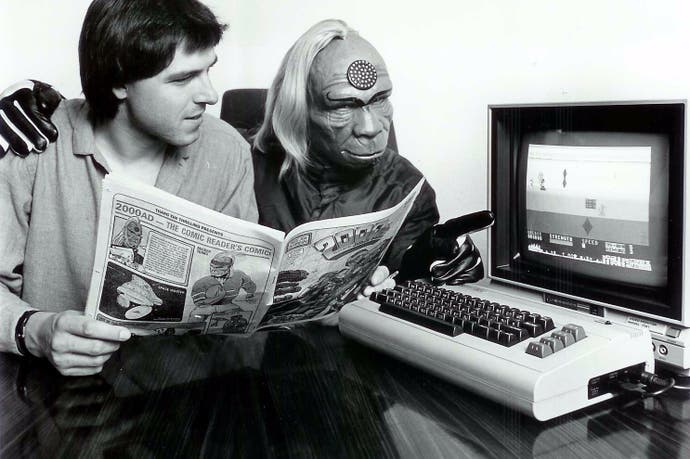A brief history of 2000AD's 8-bit games
Your move, creep.
To a young lad growing up on Star Wars and the sci-fi writings of Harry Harrison and Douglas Adams, 2000AD was a natural home when it came to my weekly comic fix. Each issue came action-packed with a range of serialisations that represented the very finest of British art and writing. I didn't have a favourite character; I loved them all. The neo-fascism of Judge Dredd's grimy, flawed universe; the distant revenge-fuelled tale of biologically-engineered soldier, Rogue Trooper; the relatively light-hearted and whimsical Ballad Of Halo Jones; and the unsubtle paean to religious genocide in the fabulous Nemesis The Warlock. These were stories that mixed sci-fi, fantasy and horror themes, eloquently told and brilliantly drawn, and it all started over 40 years ago.
The first issue would have passed me by (at four years old, I was a little too young to fully appreciate the antics of Dredd and co), but by the early 80s my local newsagent was regularly reserving me a copy of 2000AD, my name scrawled proudly across the top of each issue. Shortly after, I finally persuaded my parents that a ZX Spectrum would actually be good for my education, and eagerly awaited the inevitable arrival of 2000AD's iconic characters in video game form. Today the pull onto modern gaming platforms remains strong, as the release of Rebellion's Rogue Trooper Redux would appear to confirm. But 1984 was when it all started, and with that classic tale of a red-eyed mutant bounty hunter and his Viking chum.
Strontium Dog: The Death Gauntlet (Quicksilva, 1984)
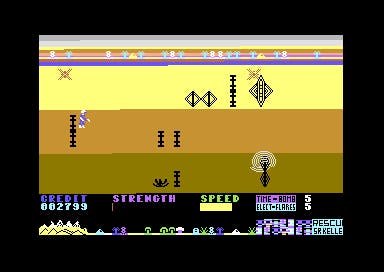
Strontium Dog: The Death Gauntlet was the brainchild of Mark Eyles, Quicksilva's software manager and a massive 2000AD fan. Coincidentally, 2000AD's assistant editor, Richard Burton, was a gaming and Quicksilva fan, making it a match made in Mega-City One. When Eyles wrote to 2000AD asking for a picture of Tharg to help add thrill-power to his games, it instigated a meeting at a ZX Microfair, and Quicksilva was soon negotiating one of the first character licences of the 8-bit era, and the first official 2000AD licence. This Commodore 64 game, developed in-house and designed by Eyles, didn't, by his own admission, 'work out quite as well as we might have liked'. The player controls Johnny Alpha in his quest to eliminate the nefarious Stix Brothers, and meet up with his pals Wulf and Gronk. It's an unremarkable side-scrolling run 'n' gunner that bears little resemblance to the comic strip, and an inauspicious start to 2000AD on home computers.
Strontium Dog: The Killing (Quicksilva, 1984)
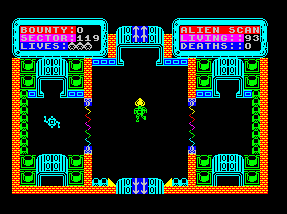
I played the Spectrum version of Strontium Dog, and this had an alternate genesis to its rival computer, and was actually a completely different game. Just as development was beginning, Quicksilva was sent a completed game by a fellow named Paul Hargreaves, who (rather incredibly) suggested it would make a good basis for a Strontium Dog licence. Back in the early 80s, such unsolicited submissions were common; bedroom coders would freely offer their efforts to software houses with dreams of becoming the next Matthew 'Manic Miner' Smith.
Hargreaves's game was called The Killing, played out over a large flick-screen maze and had an obvious link to the comic - a Strontium Dog story of the same name had appeared in 2000AD early in 1984, and inspired the coder to produce a game based around it. The story concerns a murderous contest in which various hard nuts from around the galaxy have gathered together to have a quiet drink and swap fashion tips, before attempting to slaughter each other and reap the reward. Reading the original comic apparently assists in playing the game, as Johnny takes advantage of the event to claim a few bounties. However, in truth there's not really enough to do, and it descends into a boring traipse around the many very similar screens, although, as with Death Gauntlet, it at least boasts a lovely Carlos Ezquerra cover.
Rogue Trooper (Piranha, 1986)
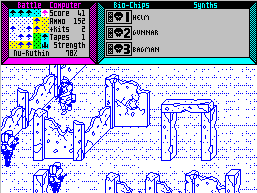
Given the recent release from Rebellion, it would seem Rogue Trooper remains one of the most popular characters from the famous comic - or maybe the easiest to shoehorn into a video game. Back in the 80s, London-based Piranha games secured a number of 2000AD licenses, most of which didn't see the light of day thanks to the publisher's abrupt demise. Rogue Trooper, however, was a moderately successful attempt at replicating the shattered world of Nu-Earth, as the player wanders around an isometric environment, despatching Nort soldiers and attempting to recover the eight vid-tapes that together reveal the Souther traitor responsible for the Quartz Zone massacre. For the first time, the tone and imagery of a 2000AD comic was capably reproduced, as an impressive Rogue and his Nort adversaries fought within the desolate landscape, the former's dead biochip pals offering up advice and tips throughout. Rogue Trooper is a relatively easy game by 8-bit standards, but uncomplicated fun nonetheless - South Side, yeah!
Nemesis The Warlock (Martech, 1987)

Piranha's competition for 2000AD licenses was chiefly Martech, another medium-sized software house, based in Pevensey Bay, Sussex. Development of Nemesis The Warlock was handled by Creative Reality, aka coders Jas Austin, Neil Dodwell and artist Dave Dew, and it's a one-screen platform game, albeit one that manages to capture the macabre tone of the comic. The player takes control of the eponymous anti-hero, eradicating terminators on each screen before facing off against the demented Torquemada himself. Nemesis The Warlock isn't the most original of 8-bit games, but offers up one particularly ingenious (and suitably ghoulish) mechanic: in order to reach the exit, the player is often required to pile up the bodies of dead foes and use them to jump onto the platform above.
Slaine (Martech, 1987)
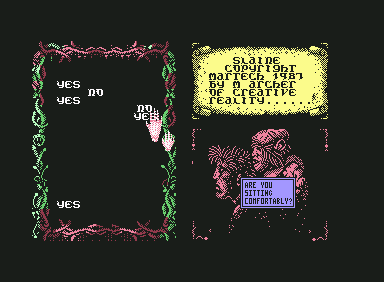
The second of Martech's duo of 2000AD games is a curious, and ultimately flawed effort, that tried to introduce a new gameplay technique that was doomed from the start. Nevertheless, the game succinctly demonstrates the capacity for original concepts that existed back in the mid-eighties. The aforementioned system was dubbed 'Reflex' and came from a misjudged idea on how to best represent the maniacal internal workings of the berserker's mind. Random actions and commands float across a window in the game screen and the player needs to select the correct command in order to proceed. Beautifully presented (with a Glenn Fabry cover to boot), and quite possibly an accurate rendition of Slaine's bizarre thoughts, the game is unfortunately too frustrating to be a worthwhile experience. Nonetheless, it's a fascinating piece of work, and a fine example of how the 8-bit computer era was often a wonderful time for creativity. And you get to hit Ukko. A lot.
Judge Dredd (Melbourne House, 1987)

With all due respect to Rogue, Nemesis and Slaine, no 2000AD licensed game was as hotly anticipated as much as Melbourne House's Judge Dredd, and how the antipodean software house would approach the subject matter was keenly debated in the press of the time. The game was a long time in the making; as early as 1985, Games Workshop had let slip to Crash Magazine that they were working on the licence, before its games division was suddenly closed down. Melbourne House had troubles too, with the game stumbling from a bountiful Christmas 1986 slot to spring the following year. Unfortunately, and somewhat predictably, the developers moulded Dredd into a dull platform game, and while it had its admirers (Sinclair User's Jim Douglas awarding it five out of five stars), there wasn't much for fans of the comic strip to sink their teeth into, and the game inevitably felt rushed, with jerky controls and a half-arsed attempt to bring comic-book stylings to the screen. The award for the worst version went to the Commodore 64; notching a pathetic 13 per cent in Zzap! magazine, reviewer Julian Rignall in particular delivered a withering verdict: 'A travesty - a complete load of bull which fails on all counts to capture the atmosphere of the character." Ouch.
The Ballad Of Halo Jones (Piranha, unreleased)

Okay, this one I didn't play, mainly because it never actually got released - but it did get made, by a coder named Mike Lewis. "I was a big fan of the comic strip," Lewis tells me. "And I approached Piranha with an idea for a game based around it. They procured the license from 2000AD on the back of my pitch." Having already produced the excellent adventure/comic mash-ups Redhawk and Kwah! for Melbourne House, Lewis was well-positioned to create the game, although how the character would actually fit into digital form was the something that was also debated at the time. "It was an exploring and fighting game where Jones moved though corridors trying to get to the shopping mall at the end of the game," he explains. "She encounters different drummers [members of a bizarre cult] and aliens on the way, and could pick up weapons such as grenades to defeat them." Underneath the gameplay screen sits Swifty Frisko, the comic's TV news presenter, who reads out headlines and tips for Halo.
"I delivered the master tapes for the Spectrum and Amstrad versions to Piranha on the day that they were wound up by MacMillan Publishing [its parent company]," says Lewis, who was at least paid his advance, although no-one else was able to publish the game due to licensing complications. It's a shame Halo Jones never got to appear on the home computers: a strong female protagonist was rare at the time, and early previews noted it as a mix of Gargoyle's famous expansive adventure, Tir Na Nog, and the classic one-on-one beat-'em'up Way Of The Exploding Fist. There's further bad news: Lewis disposed of all his old computers and backups sometime in the mid-Nineties, long before the current interest in retro gaming had taken hold, thus consigning Halo to the bowels of The Hoop forever.
Judge Death (Piranha, unreleased)
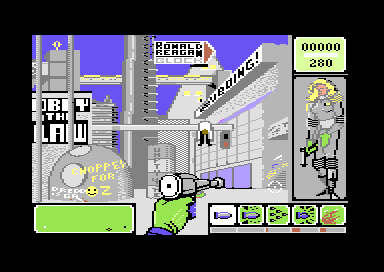
As with The Ballad Of Halo Jones, Judge Death was heavily promoted - and even featured in a 16-page comic/advertisement given away with some magazines - but also caught up with the demise of Piranha Software. The game looked ambitious, with the player taking control of Psi Judge Anderson in an attempt to stop the eponymous Dark Judge turning the population of Mega City One into shambling zombies. Development originated in Hungary, and its previews looked impressive, at least on the Commodore 64. A first-person shooter, it included an on-screen graphic of the player's hand and gun as they navigated across the city, rescuing innocents while destroying the minions of Death. A playable version of a game called Horror City is available from another Hungarian developer, and would appear to be the same game, although whether the Commodore 64 would have had enough power to shift the required range of graphics adequately is another matter. For further information, check out the game's entry on the excellent website, (Judge Death - Games That Weren't)
Judge Dredd (Virgin, 1990)

After Melbourne House's mediocre version of everyone's favourite fascist cop, Virgin Games had another stab at recreating instant justice several years later. Alas, as with the previous effort, things didn't quite run to plan; it was only released to any meaningful degree on the Commodore 64, and received middling reviews again, mostly expressing disappointment at another wasted opportunity. The game was developed by The Sales Curve which had just enjoyed great success with the arcade conversion Silkworm, also for Virgin.
Simon Pick was project manager for Judge Dredd, and he takes up the story. "I'd just finished work on the Commodore 64 version of Shinobi, and had the vague idea that we'd just make a similar game, but styled to the Dredd universe. That seemed like a good idea until someone noted that Judge Dredd never jumped, at which point we should have given up on the idea of making it a platform game." However, the team pressed on with the template, and put together artistic mock-ups that looked very impressive, according to Pick. "But for technical reasons, we couldn't actually get them working in the game, and we rapidly fell back on the orthographic projection that is in the final game."
Despite reviews appearing for the Spectrum and Amstrad games, it was assumed unreleased, until a copy of the former version appeared on eBay several years ago. With an inexperienced development team, up against a tight deadline and dropping features on a weekly basis, Judge Dredd mk2 is an example of how, by 1990, the shrinking 8-bit market was constricting the creative process, and a sad end to the legendary comic on those computers.
